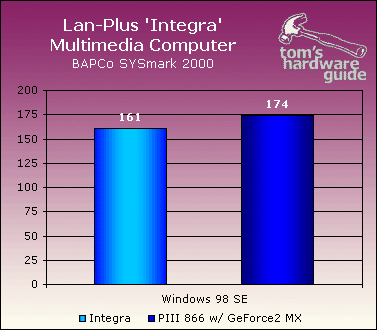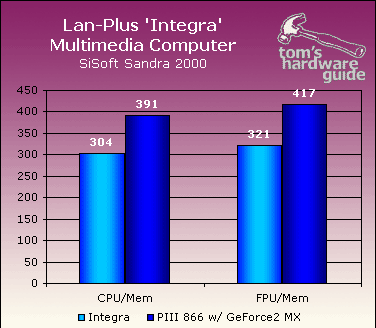Multimedia-Center: The Lan-Plus Integra
Benchmark Comparison - BAPCo SYSmark 2000 - Windows 98 SE
It is pretty obvious that the Integra PC cannot keep pace with my reference system. The difference of 13 points is based in the slower hard drive and the slow FSB speed of the Integra CPU: The Pentium III 850 works at only 100 MHz FSB, while the Pentium III 866 runs at 133 MHz. Since the main memory runs at this clock as well, both the CPU interface and the memory bandwidth are considerably faster with our reference machine.
The Western Digital hard drive stores 20 GB and works at 5,400 rpm. In contrast, we have been using the IBM DTLA drive for many months now, as it provides both quick access times and fast data transfer rates thanks to 7,200 revolutions per minute. In terms of this benchmark, the WD drive will cut the benchmark score by 2-3 points (I did not include that in the chart).
The 2D-graphics performance, however, is not affected by the 'older' ATI graphics card. Even after equipping our reference system with the Rage 128 Pro card, which Lan-Plus integrates into the Integra, the SYSmark result remains the same.
SiSoft Sandra 2000 - Synthetic Memory Benchmark
Many of our readers like this benchmark, since it gives you a good basis for comparisons between the theory (the Sandra 2000 memory benchmark) and the real world (other benchmarks). As expected, the Integra cannot keep pace with the faster memory transfer speeds - no matter if the operation affects the integer or the FPU unit.
Get Tom's Hardware's best news and in-depth reviews, straight to your inbox.
Current page: Benchmark Comparison - BAPCo SYSmark 2000 - Windows 98 SE
Prev Page System And Test Setup Next Page Mercedes Benz Truck Racing
Patrick Schmid was the editor-in-chief for Tom's Hardware from 2005 to 2006. He wrote numerous articles on a wide range of hardware topics, including storage, CPUs, and system builds.

